TWO DISAPPOINTING FAILURES, TWO DELICIOUS SUCCESSES
Help!!
As flaming red petals drop to the ground beneath my pomegranate bush, I’m not hopeful. Sure, the flowers are beautiful, but the plant is here to give me fruit.
To survive winters here in New York’s mid-Hudson Valley (Zone 5), my plant’s home is in a large flowerpot which I cart into cold storage in late December and back outdoors or into the greenhouse in late winter or early spring. Even my cold-hardy variety, Salatavski, from western Asia, would die to ground level if planted outdoors. The roots would survive that much cold because of moderated below ground temperatures, but new stems that would rise from ground level would need to be more than a year old before flowering.
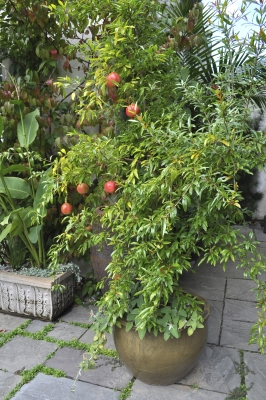
Potted pomegranate, but NOT mine
Growing in a pot, my pomegranate (and other potted fruit plants) need regular pruning and repotting. To prune the pomegranate, I snip off young suckers growing from ground level, shorten lanky stems, and thin out stems where congested. I repot the plant every 2 or 3 years, cutting off roots and potting soil from around the root ball to make room for new potting soil.
When flowers do appear, which they do over the course of a few weeks, I dab their faces with an artists’ brush. Going from flower to flower spreads the pollen from male flowers to the female parts (stigmas) of the hermaphroditic flowers.
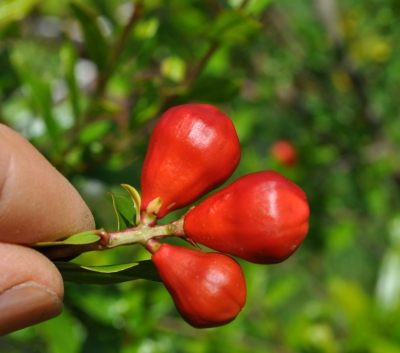
Male pomegranate flowers
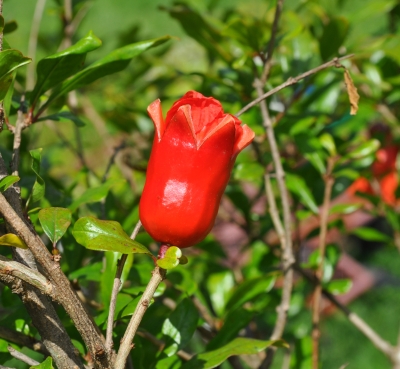
Hermaphroditic pomegranate flower
Then I wait, my eyes concentrating on each flower and hoping to see the base swelling. Problem is most, some year all, the flowers open and then drop. Occasionally, in past years, a flower or two has swelled into a mini-pomegranate. Then also dropped.
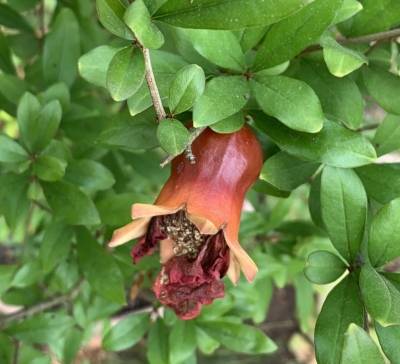
Swelling pomegranate fruitlet
I’ve ministered to this plant for years and it has never rewarded me with a single fruit. Help! Any suggestions?
Not So Idle Threats
Every summer, as my pomegranate drops its last flowers, I’ve threatened it with the same fate I wrought upon another of my subtropical fruit plants, pineapple guava. Beneath the thin, green skin of this torpedo-shaped fruit lies a gelatinous center with a minty pineapple flavor.
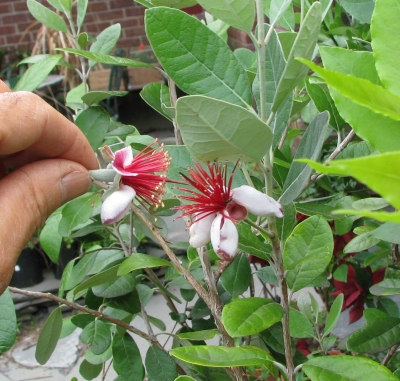
Pollinating pineapple guava
Over the course of growing this fruit for many years, I did harvest a few, small fruits from this plant, but not enough to keep me from reincarnating it as compost. (The flowers, however, reliably produced, sport the most delicious, fleshy petals of any that I’ve taste, with a strong, sweet minty flavor.)
A Most Delicious Fruit
Not all has been failure with my growing subtropical fruits.
My most recent success has been with Pakistani mulberry, Morus macroura, native to Tibet, the Himalayas, and mountainous regions of Indochina. I first tasted this fruit a few years ago at a nursery in Washington State and was swept away by the delicious flavor, sweet with enough tartness to make it interesting, and a strong berry undertone. (Yes, mulberry does have “berry” in its name, but botanically, it’s not a berry; it’s a “multiple fruit.”)
Besides having great flavor, Pakistani fruit is also notable for its enormous size, each one elongating, when ripe, to between three and five inches!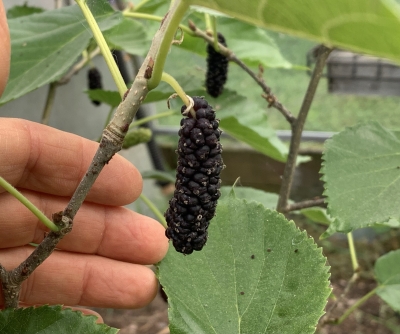
Pakistani mulberry is easy to grow and needs no particular coaxing to bear plenty of fruit, which it does over the course of a few weeks. Mine grows in a pot measuring a little over a foot wide, with the tree rising about four feet high. Fruits are borne on new shoots that grow off older stems, which keeps the tree very manageable. Shortening those older stems each year makes it easier to muscle the plant through doorways to move it indoors for winter and then back outdoors when weather warms a little.
Very Easy, Very Successful, Very Delicious
My longest term and greatest success with subtropical plants has been, of course, with figs. (I write “of course” because I’ve written a whole book whose content is described by its title, Growing Figs in Cold Climates, and now is available as a video of a webinar I have presented on that topic.)
Like mulberries, to which they are related, figs — most varieties — can bear fruit on new shoots that grow off older branches. 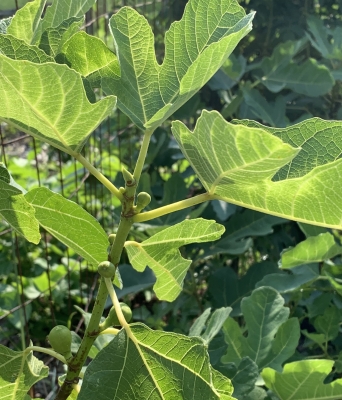 So, like mulberry, the plants can be pruned back some so they’re more manageable to be protected from bitter winter cold. An in-ground plant, then, could be protected from bitter winter cold by being swaddled upright or lowered to the ground, even trained to grow along the ground; a potted plant is more easily maneuvered into a garage, unheated basement, or other cool location for its winter rest.
So, like mulberry, the plants can be pruned back some so they’re more manageable to be protected from bitter winter cold. An in-ground plant, then, could be protected from bitter winter cold by being swaddled upright or lowered to the ground, even trained to grow along the ground; a potted plant is more easily maneuvered into a garage, unheated basement, or other cool location for its winter rest.
Right now, there’s nothing for me to do with my figs except watch them grow. Small figlets now sit in the plants’ leaf nodes. They’ll just sit there, doing nothing, for a seemingly long time. Once ripening time draws near, the figs suddenly puff up, becoming soft and juicy and developing a honey sweet, rich flavor.


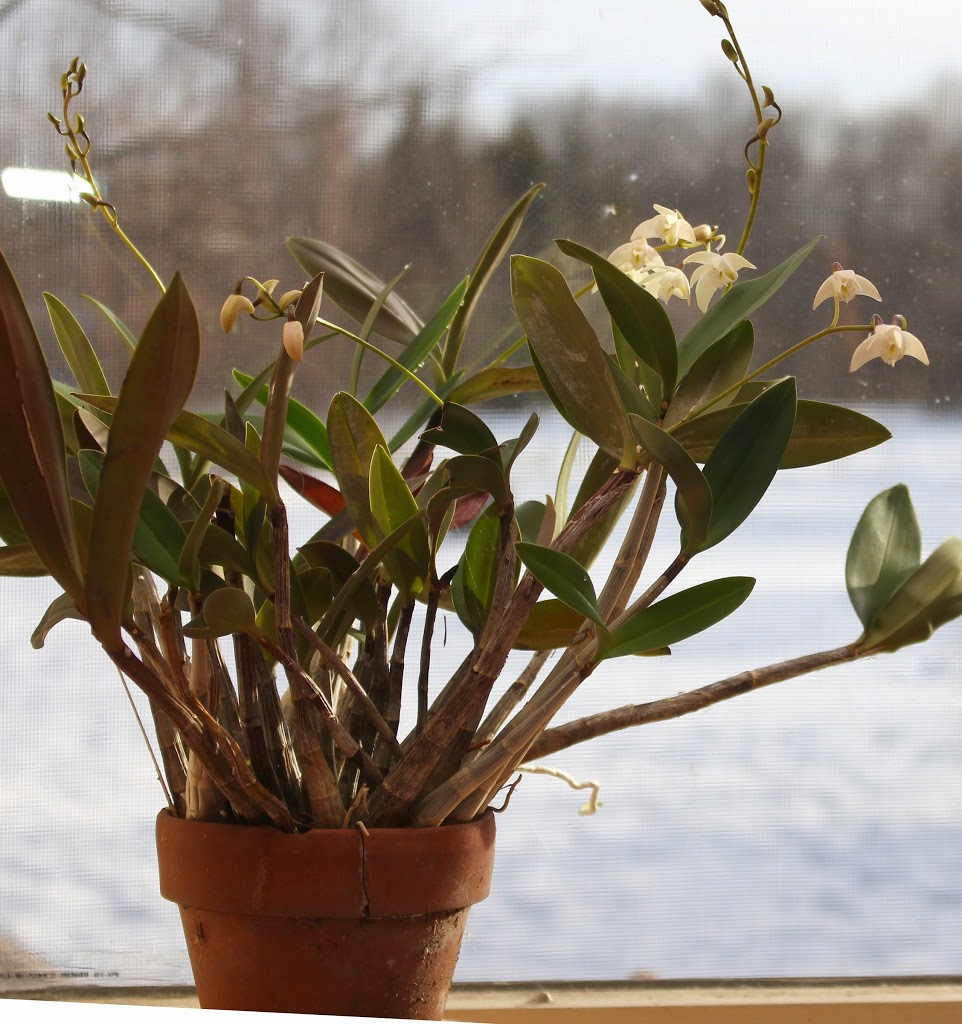
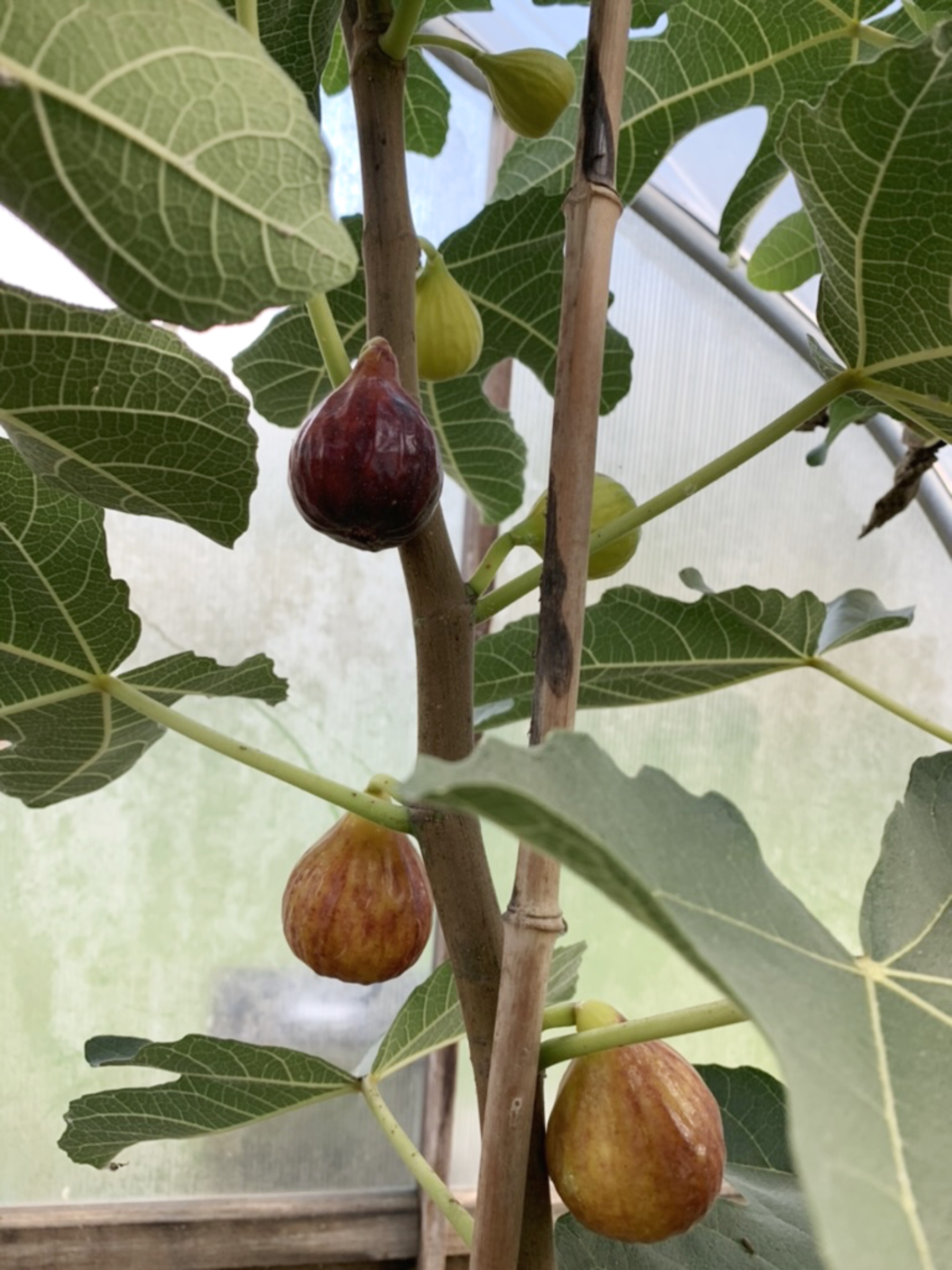
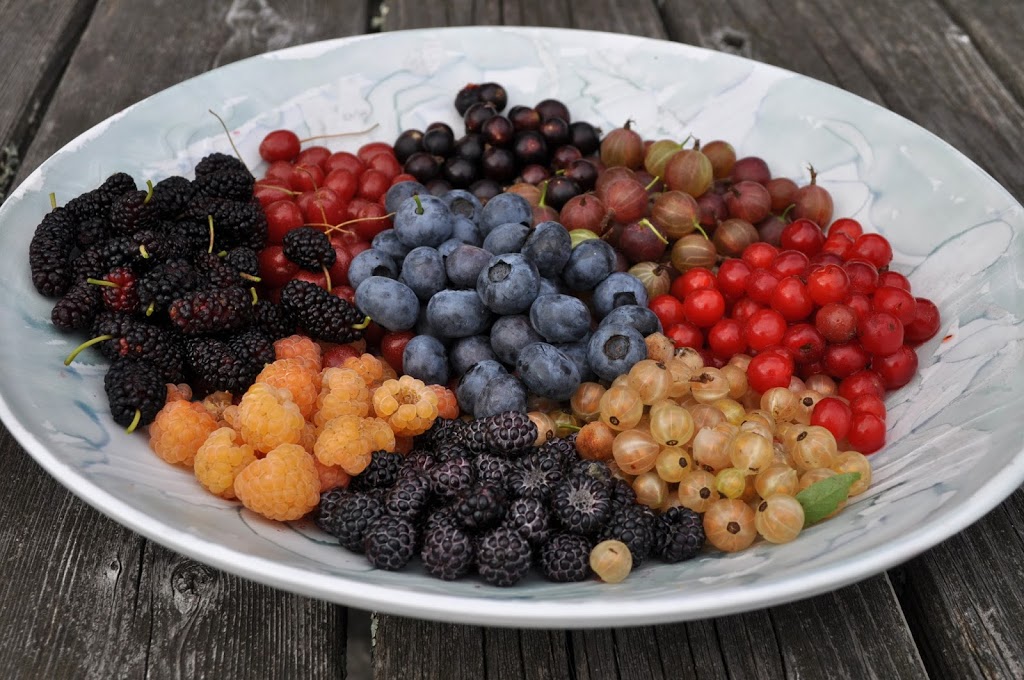

Our garden is full of more birds than I have ever seen. I fully enjoyed this site until I realized that ALL my gooseberries, red currants and raspberries were gone. I had a net pinned over them but they branches were utterly and completely cleaned off. I nearly cried. Any sage advice?
Better netting method. Odd that the birds would eat all those berries. They never touch my gooseberries or currants, and just eat a few raspberries.
My failure is the figs. Not sure what I’m doing wrong. I’ve had the about three years, but no fruits. Are they still too young?
Could be insufficient light or growth, or not pruning correctly.
I never had a problem with birds eating my currant and related berries until three years ago catbirds nested nearby and I caught them sampling the fruit. Ever since I have had to share with the local birds. My theory is that these fruits were unfamiliar to the local avian population and so were ignored until their delicious nature was discovered.
Hi Robert, I have catbirds here who, I guess, have — fortunately for me — never sampled the fruit.
By the way, my cardoons are about to open their flowers.
I have 8 plants and all were stripped clean even though they were covered with bird netting. I suspect chipmunks because they can crawl under the netting.
Blame most such things on chipmunks of squirrels, both in abundance these days.
Laura
Hi Laura, What’s that mean?
I managed to harvest a couple pounds of gooseberries from my 2 bushes. Chipmunks were seen eating those I left behind, but I suspect birds helped too.
Helping? Don’t the chipmunks and birds keep (eat) those that they “help” harvest? (ha, ha)
I have had a horrid time with chipmunks and voles. I thwarted the voles this year by removing ALL the mulch from the beds and paths. Not pretty and I have to deal with the soil splashing up on my edibles, but no more voles- or slugs. But the chipmunk population needs to be “reduced”. They live in the stone walls and wood piles and ate EVERY strawberry and now are on to the raspberries and blueberries. You can’t cover the bushes enough to keep them away. And no, I do not have a cat! Any repellants that you k now that work??
BTW, Surround works FABULOUSLY at repelling Japanese beetles from my grapes!!!!
I don’t think there are repellants. Another option is to trap.
Thanks for the tip about Surround.
I never used any netting and also find it very odd that birds have never eaten any of my currants, gooseberries, raspberries, blueberries or elderberries. I sometimes wish they would to make picking easier.
Birds to make picking easier??
I have the same experience here in Ireland as you in NY:
Potted pomegranate flowering but dropping these flowers. This year I planted it out – no flowers yet. I doubt that Irish summers have enough heat to ripen the fruit anyway, so the pretty foliage will have to do.
I have 3 varieties of pineapple guava. I did get a few fruit from them when they were in pots and under glass. I planted them out 2 years ago and they are blooming now so I hope I may get some this year. Unsure how much heat they will need to ripen.
And the mulberries are growing and fruiting like crazy Mojo/Charlotte russe does well but not very tasty – the birds are delighted.
Illinois overbearing also fruits like crazy and is very tasty.
Persian black and Chelsea fruit in low numbers and are tasty.
My 5 or 6 Fig varieties suffered a lack of watering during a recent week’s holiday in hot weather – which means some lost all leaves – I hope they will recover.
Great reading in your column this week – I can compare and learn on a lot of points.
Yes, very interesting to compare. Our climates are very different: I have very cold winters and fairly long, hot summers. I assume you have relatively mild winters and cool summers. Yes? My pineapple guavas were always outdoors in summer, in pots. They do need a long, hot summer to ripen. But enjoy the flowers; they’re delicious.
That’s kinda funny, reading what you said about the Pineapple Guava. This Summer has been the last straw! I’m sooo very tired of watering this thing all season and then hauling it indoors for the Winter. Meanwhile, after years & years I’ve gotten ZERO fruit. Blooms? Sure. No fruit. This year I’m getting more pragmatical than ever & I’m reassessing everything without the distorted lens of sentimentality…
I’mm moving more and more in that direction.As Charles Dudley Warner so aptly put it in his 150 year old book “My Summer in the Garden”: I have seen gardens which were all experiment, given over to every new thing, and which produced little or nothing to the owners, except the pleasure of expectation.
Do you know of a wholesale source for the Pakistani mulberry?
Can’t help you out with this. Perhaps contact a nursery that sells it and ask if wholesale pricing available.
I’m in Santa Barbara and my Pomegranates were turning red LAST MONTH. Very depressing climate change indicator. D
Why? Too early?
Even here in Atlanta, pineapple guavas are temperamental. They are said to require cross-pollination, and it isn’t always easy to find multiple named varieties. They are slow to maturity and flowering seems sensitive to some aspect of the weather. I would describe the flowers I’ve tasted as tasting like Juicy Fruit gum.
To me, they have a much cleaner flavor than Juicy Fruit gum. There are some varieties, such as Coolidge, that are reputedly self-fruitful. Mine didn’t seem to be.
I have 2 pomegranates in Gardiner NY. This year they have only set a few fruit. One is called Russian #8(Salavatski) and it usually produces more fruit than the Wonderful. I have gotten over 10 lbs of fruit a few times. Hummingbirds feed on the flowers. I don’t try hand pollination. They are in 20 gallon plastic containers that are partly buried. Our soil has great drainage. The roots grow into the ground and get cut off when I move them in the fall. I don’t think they’ve ever been repotted. I give them a couple of doses of fertilizer with high phosphorous (like Miracle Grow Bloom Booster) in the spring. I bought one from you many years ago (from Iran ?) and it didn’t fruit and I gave it away after a few years. Maybe you need to try a different variety.
!!!!!!!!! Can I come see it? Do yours ripen within our relatively short season (for pomegranates)? Their flavor?
I have only one pomegranate now, the variety Sverkhranniy. I must have scared my plant because this season, for the first time, two fruits are developing.